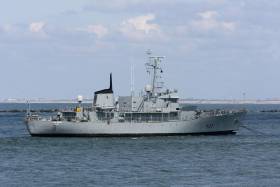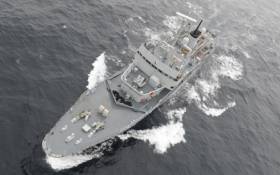Displaying items by tag: Former LE Aisling
Irish Navy's Former L.E. Aisling Redesigned As ‘Superyacht’
#newsupdate- Designs have been drawn by an Australian company to convert the State’s former Naval Service patrol ship Aisling into a luxury “superyacht”.
As The Irish Times writes the proposed refit could cost several million US dollars, but would add significantly to the value of the 64 metre patrol ship.
The Aisling, formerly “long Éireannach”, (as Afloat previously reported sold at auction) is currently on sale with Dutch shipbrokers Dick van der Kamp and has been renamed Avenhorn.
The “concept proposal” drawn up by Sabdes Design of Sydney for the Dutch brokers involves two options for refit in a “modern classic style,” allowing for ample leisure facilities and helicopter pad on deck.
For more on the story click here.
And for the latest drawing on Aisling's conversion click here and scroll across
Auctioneer Defends Price Fetched for Former LE ‘Aisling’
#AislingResale - An auctioneer in Cork who handled the State’s sale of the Naval Service patrol ship LE Aisling for €110,000 has said he is not surprised if the vessel is now being advertised at multiples of that figure, writes The Irish Times.
A Dutch ship broking agency which purchased the ship at auction in late March is advertising it for sale in “very good condition” but with no guide price on its website.
The Permanent Defence Forces’ Representative Association (PDFORRA) had expressed concern that the price was being quoted at $750,000 - approximately €685,000.
Auctioneer Dominic Daly,who sold the Aisling’s sister ship, Emer, to a Nigerian businessman for €320,000, said he was “delighted” the new owner was”trying to make the best of his purchase”.
Mr Daly pointed out that classification of a ship to meet international surveying standards involves “considerable cost”, and Naval Service ships are not classified.
“Mr [Dick]Van der Kamp would have had to pay for reclassification,which involves putting the ship in dry dock, along with fuel costs for delivery to Holland,”he said.
Mr Van Der Kamp said at the time that it was too early to say whether he had got a bargain as the market internationally for offshore vessel was very depressed.
To read more on this story, click here.
#AvenhornArrives – Former Naval Service OPV LÉ Aisling under her new name Avenhorn arrived in Dutch waters following a five-day towage delivery voyage, writes Jehan Ashmore.
The operation began on Sunday to tow Avenhorn from Cork Harbour from where the oldest unit of the navy dating to 1980 had been laid-up in the Naval Basin on Haulbowline.
The final 'Emer' class OPV built by Verolme Cork Dockyard had served the navy for 36 years until decommissioned last year in her adopted homeport of Galway.
Bere Island based tug Ocean Bank which at 33m is more than half the length of Avenhorn arrived on Thursday to navigate the New Waterway (Nieuwe Waterweg). The canal connects the North Sea and the Port of Rotterdam.
Last month Dutch shipbroker, Dick van der Kamp Shipsales B.V. bid for the vessel that was sold at public auction for €110,000 through auctioneer Dominic Daly.
The new owners plan to refurbish Avenhorn which is registered in Belize and then place the vessel for re-sell.
Former LÉ Aisling Renamed Avenhorn to Set Sail Sunday
#Aisling2SetSail- The former LÉ Aisling which was sold at public auction last month has been renamed Avenhorn by Dutch owners, and is expected to depart Cork Harbour tomorrow for the final time, writes Jehan Ashmore.
Afloat has noted that the departure of the sole surviving ‘Emer’ class OPV built in 1979 by Verolme Cork Dockyard, is to take place one month after the auction on 23 March. The veteran vessel went under the hammer for €110,000 is to be towed to the Netherlands. This is involve the Bere Haven based Ocean Bank operated by Atlantic Marine & Towage.
LÉ Aisling in design terms is derived from the original LÉ Deirdre. However, LÉ Aisling became the third and final sister of an improved version belonging to the 'Emer' class that included LÉ Aoife.
In a career that lasted 36 years, LÉ Aisling was engaged in numerous missions, rescues, UN supply missions to the Lebanon. In addition the OPV served routine domestic fishery protection duties and those concerning arms and drugs interdictions.
The auction conducted by Cork based auctioneer Dominic Daly led to the sale of the 65.5m OPV to Dutch shipbroker Dick van der Kamp Shipsales B.V. They plan to refurbish the 1,025 displacement tonnes which has been re-registered in Belize before re-selling it to subsequent owners.
The disposal of LÉ Aisling paved the by way for direct successor LÉ William Butler Yeats, the third OPV90 class so far completed in the current Naval Service Vessel Replacement Programme. A fourth sister to be named LÉ George Bernard Shaw is under construction at a UK yard, Babcock Marine & Technology in Appledore, Devon.
LE Aisling As Museum Considered In Government Proposal
#AislingsFuture - A decommissioned Naval Service ship may be turned into a museum in Galway, writes The Connacht Tribune.
The idea of using the LÉ Aisling as a visitor attraction in the city, has been floated with Government.
Paul Kehoe, Junior Minister at the Department of Defence, this week said the request is “under consideration”.
The ship, which had been twinned with Galway City for almost 20 years, has travelled 628,856 nautical miles, the equivalent of travelling around the world more than 32 times.
It was decommissioned at a ceremony in Galway Harbour in June after 36 years of service to the State.
At the time, City Councillor Pearce Flannery (FG), the deputy mayor, suggested it could be used as a floating museum in Galway Harbour or off Salthill.
Minister Kehoe this week said he would soon make a decision as what to do with the LÉ Aisling. To read more click here.

































































